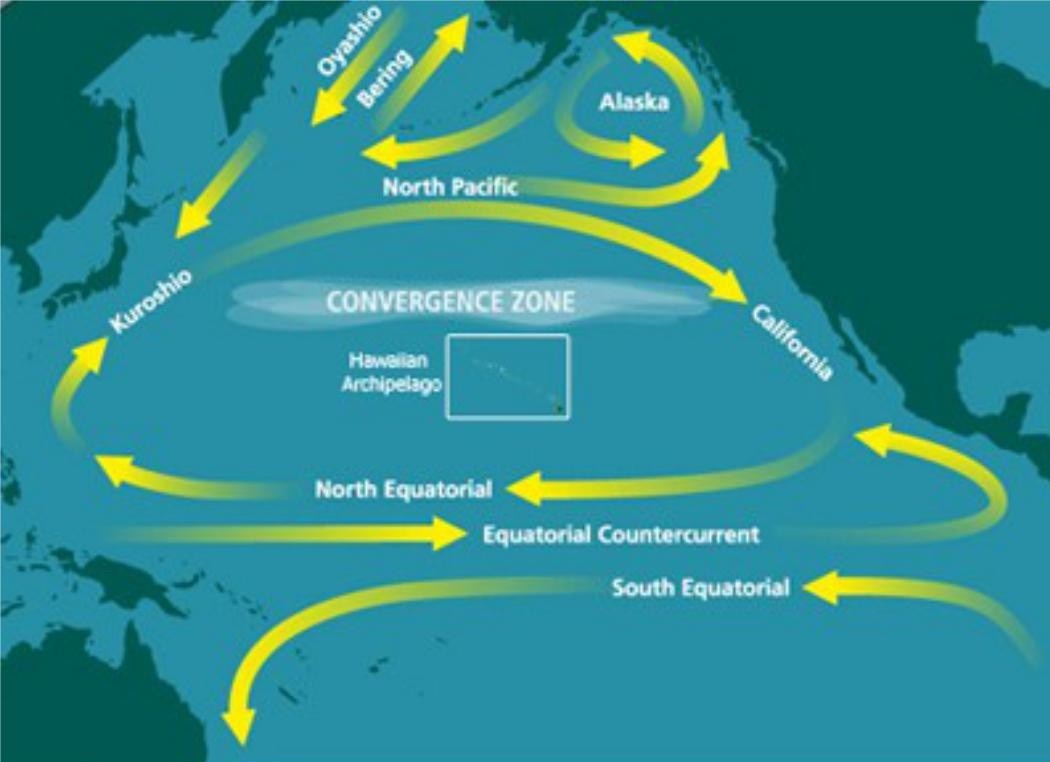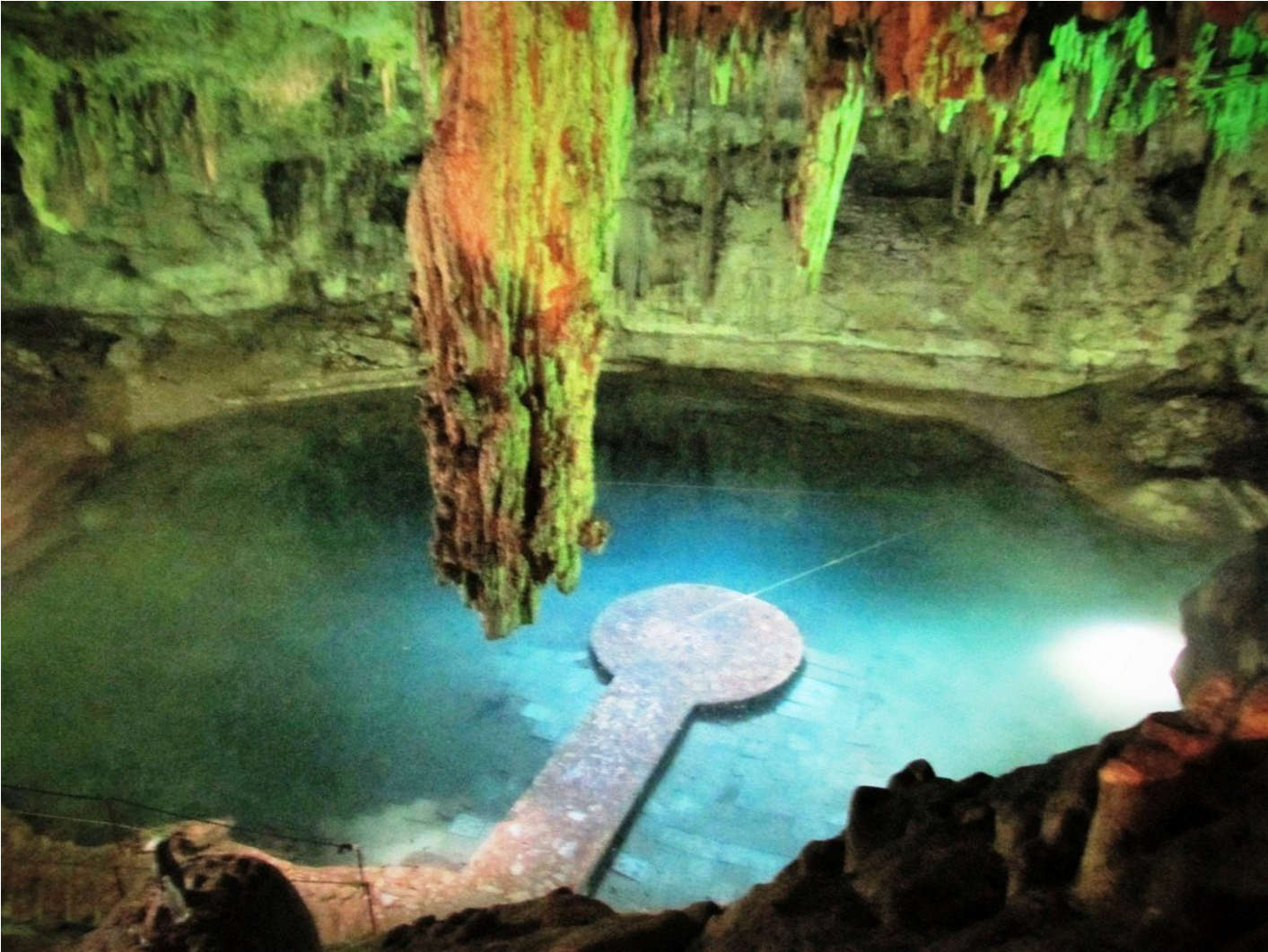By Dan and Lisa Goy series from the December 2017 Edition
January 26-28, 2016 (Days 20-22)
After three weeks into our 90-day “Mexican Adventure”, our group was really in the groove and the gang was up and ready to say goodbye to Uxmal and hello to Mérida, the capital city of the Yucatán State, at the crack of 9 am. Grant and Anita were our caravan leaders for this leg of our journey, only 77 km. Some great scenery on the way for this short drive to our destination, the 50-site Rainbow RV Park on the east side of Mérida.
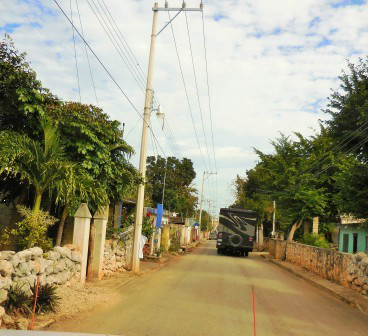
Jumping on the ring road (Periférico), we found the park easily enough, not far from the junction with Hwy 261, later after gathering in the Liverpool Mall parking lot across the street, we found the entrance. The fee was reasonable at $250 pesos per RV which included water, power, sewer, clean washrooms and showers that included resident iguanas. After we got settled in
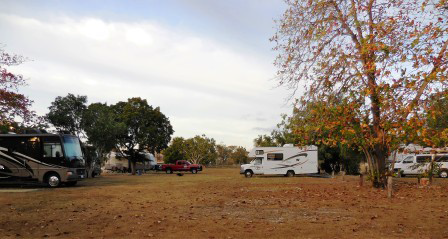
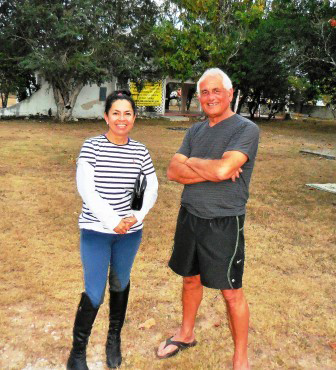
Patricio, the co-owner showed up to welcome us to Mérida. Next, we headed over to Liverpool Mall to do some shopping and banking, which included a Costco, Mega grocery store and, believe it or not, a skating rink! (also great wifi). Before the day ended, we made reservations for the double decker Turibus with an open-air seating on top.
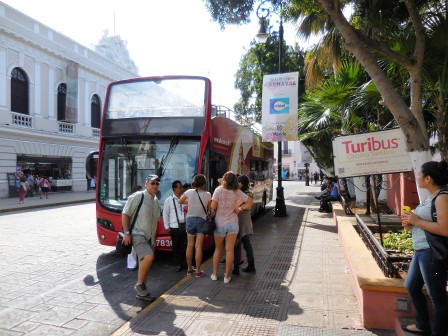
Day 2 in Mérida, everyone loaded into the bus and we headed downtown for a 9am pickup at the Holiday Inn, with help from our GPS, Molly. The weather cooperated with some sunny breaks but not too hot. Originally, we believed there were a few stops on the bus tour, turns out not really to be the case, only one, the Historic Centro Zócalo. Mérida has been the centre of commerce in Mexico for almost 500 years and you could tell.
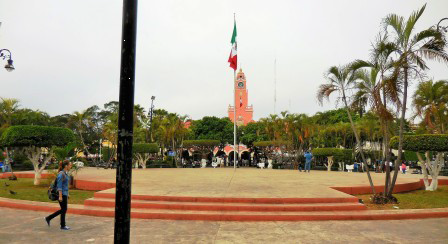
Mérida offers abundance of opulent mansions, manicured tree-lined streets and high-end shops. We were dropped off at the Zócalo and spent almost 2 hours seeing the sites in these 6 square blocks, including the San Ildefonso Cathedral, State Building and surrounding historic sites; so much to see. Lots of walking, photo taking and pricing items.
As expected, most goods were very expensive so close to the historic heart of the city. We met back up with the bus after lunch and arrived at the Holiday Inn where we had started, close to 1pm. We did see and enjoy much of downtown Mérida from our vantage point in the upper seats of this bus for only $100 pesos per person. After returning to the campground, the guys headed out to refill bottles with purified water. Most of us headed out on foot that evening for pizza nearby the camp-ground.
Our 3rd day in Mérida, we had nothing special planned, folks are mostly taking a day off, the weather is changing, a little cooler and not so much humidity. We did organize a visit to a Mega grocery store not far away for supplies. I also had time to send the blog post from the mall. A few of us are heading down the road on foot in the afternoon to visit the recently completed El Gran Museo del Mundo Maya de Mérida (Museum of Mayan Anthropology). This was fabulous, with great exhibits that really told the story of Mayan history and culture. It also has a wonderful photography exhibit in an out-side gallery and an art exhibit at an upper level in the museum.
Again the entry fee was minimal, perhaps 20 pesos ($1 USD). This was a terrific way to end our time in Mérida, definitely a city worth visiting again in the future. Tomorrow all our Baja Amigos are off to Celestún with Roland and Janice in the lead, located on the west from Mérida on the Gulf Coast in the Parque Natural del Flamingo to take a tour of surroundings and see these birds.
Mérida background
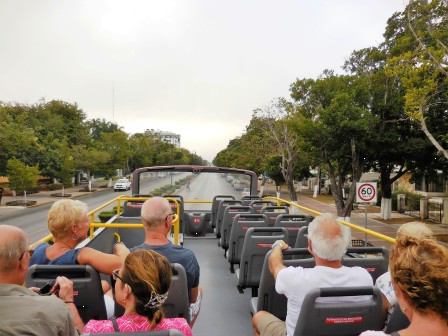
Mérida is the capital and largest city of the Mexican state of Yucatán as well as the largest city of the Yucatán Peninsula. Founded in 1542 by Francisco de Montejo y León (“el Mozo”) and named after the town of Mérida in Extremadura, Spain. It was built on the site of the Maya city of T’hó, which was also called Ichkanzihóo or Ichcaanzihó (“City of Five Hills”) in refer-ence to its pyramids. T’ho had been a center of Mayan culture and activity for centuries: because of this, some histori-ans consider Mérida the oldest continually-occupied city in the Americas. According to the 2010 census, the population of Mérida was 970,377, ranking 12th among the most populous Mexican metropolitan areas. The metropolitan area includes the municipalities of Mérida, Umán and Kanasín and had a popula-tion of 1,035,238 in the same 2010 census. It is the largest of the four cities of the world that share the name Mérida, the other three being in Spain, Venezuela, and the Philippines. The city, like much of the state, has heavy Mayan, Spanish, French, British and, to a lesser extent, Dutch influences. Mérida has the highest percentage of indigenous persons of any large city in Mexico with approximately 60% of all inhabitants being of the Maya ethnicity.
History of Mérida (Summary)
There were three Spanish conquistadors named “Francisco de Montejo”: Francisco de Montejo “el Adelantado” (“The Lieutenant”, the eldest); Francisco de Montejo y León “el Mozo” (“The Boy”, his son); and Francisco de Montejo “el Sobrino” (“The Nephew”). As we mentioned earlier, Mérida was founded in 1542 by Francisco de Montejo y León (“el Mozo”) and named after the town of Mérida in Extremadura, Spain. As Mérida was built on the site of the Maya city of T’hó, the carved Maya stones from ancient city were widely used to build the Spanish colonial buildings that are plentiful in downtown Mérida and are visible, for instance, in the walls of the main cathedral. Much of Mérida’s architecture, from the colonial period through the 18th century and 19th century, is still standing in the centro histórico of the city. From colonial times through the mid-19th century, Mérida was a walled city intended to protect the Peninsular and Criollo residents from periodic revolts by the indigenous Maya. Several of the old Spanish city gates survive, but modern Mérida has expanded well beyond the old city walls.
Late in the 19th century and the early 20th Century, the area surrounding Mérida prospered from the production of henequén. For a brief period, around the turn of the 20th cen-tury, Mérida was said to house more millionaires than any other city in the world. The result of this concentration of wealth can still be seen today. Many large and elaborate homes still line the main avenue called Paseo de Montejo, though few are occupied today by individual families. Many of these homes have been restored and now serve as office buildings for banks and insurance companies. Korean immigration to Mexico began in 1905 when more than a thousand people arrived in Yucatán from the city of Incheon. These first Korean migrants settled around Mérida as workers in henequén plantations.
Mérida has one of the largest centro histórico districts in the Americas (surpassed only by Mexico City and Havana, Cuba). Colonial homes line the city streets to this day, in various states of disrepair and renovation; the historical center of Mérida is currently undergoing a minor renaissance as more and more people are moving into the old buildings and reviving their for-mer glory. In June 2007, Mérida moved its city museum to the renovated Post Office building next to the downtown market. The Museum of the City of Mérida houses important artifacts from the city’s history, as well as an art gallery.
Early History of the Mayans
One of the most advanced indigenous cultures of the ancient Americas, the Mayans began as hunter gatherers and migrated into the Yucatán around 2500 B.C. During the pre-classic period (500 B.C.-250 A.D.) they appeared in Quintana Roo, where they established ceremonial centers at Coba, Dzibanche and Ko-hunlich. Quintana Roo was considered to be the gateway to the Mayan world. Between 300 and 900, the Mayans built several cities in the Yucatán region, two of the most spectacular being Chichén Itzá and Uxmal.
According to legend, when Francisco Hernández de Córdova arrived on the coast of Yucatán, he asked the natives where he was. They replied in their native tongue that they didn’t under-stand what he was saying. Because Córdova thought their an-swer sounded like the word Yucatán, he gave that name to the region. In 987, the Toltec people—believing they were following their god Quetzalcóatl—arrived in the region. According to Toltec mythology, Quetzalcóatl demanded human hearts as sacrifice, and the Toltecs obeyed by conducting mass human sacrifices. The Toltec’s cultural influence on the Mayans in Yucatán was profound, and their architectural influences are evident at Chichén-Itzá. Although the Toltecs mixed with the Mayans and other groups, their culture eventually dominated the area.
During the 12th century, the Mayan city-state of Mayapán waged war against and defeated the citizens of Chichén Itzá. Mayapán expanded its influence over the region, and the Mayan Cocom dynasty ruled until the mid-13th century. When the post-classic Mayan period ended around 1250, most cities were abandoned. Those that remained continued to engage in inter-city military conflicts. The disappearance of these great Ma-yan civilizations remains a mystery; had the Spanish not de-stroyed the majority of Mayan codices and other writings, the Mayan’s fate might be known today.
Spanish conquest
In 1527, Francisco de Montejo set out to conquer Yucatán but was routed by the natives. Three years later, he returned with his son Francisco de Montejo y León but again failed to over-power the indigenous population. Finally, a third attempt in 1537 was successful, and de Montejo founded the cities of Campeche in 1540 and Mérida, the present capital, in 1542. Gaspar Pacheco, known for his cruel treatment of the Indians,completed Spain’s conquest of the area. In an effort to convert the indigenous people to the Catholic faith, Franciscan priests built more than 30 convents in Yucatán and tried to replace Mayan culture with Christianity. In 1562, Franciscan monk Fray Diego de Landa ordered that all handmade Mayan books and statues be destroyed. Few of these rare and important cultural artifacts survived. In addition, Spanish oppression and dis-eases significantly reduced the native population from an estimated 5 million in 1500 to 3.5 million a century later.
Jacinto Canek, a convent-educated Mayan, led an indigenous rebellion against the government in 1761. The fighting resulted in the deaths of thousands of natives and the execution of Canek in the city of Mérida. Other indigenous revolts during the colonial period gave Yucatán’s natives the reputation of be-ing fierce and difficult-to-conquer warriors.
History post independence from Spain
When Mexico gained its independence from Spain in February 1821, Yucatán became part of the Independent Mexican Empire but remained a remote province until 1824 when it was divided into three states: Campeche, Quintana Roo and Yucatán. In 1835, a conservative unitary system of government was instituted in Mexico and given authority over Yucatán. An insurrec-tion advocating Yucatecan independence erupted in Tizimín in May 1838; in 1840, the local Congress approved Yucatán’s dec-laration of independence. Hoping to settle the differences, Mexico’s President Antonio López de Santa Anna sent Andrés Quintana Roo to Mérida in 1841. Quintana Roo signed a treaty with the local government, which Santa Anna ignored. Hostili-ties resumed, and Governor Méndez ordered all Mexican flags removed from Yucatán buildings and ships in favor of the flag of the “Sovereign Nation of the Republic of Yucatán.”
Refusing to recognize Yucatán’s independence, Santa Anna or-dered that Yucatán’s ports be blockaded. He also sent an army to invade Yucatán in 1843. The Yucatecans defeated the Mexi-can force, but the loss of economic ties to Mexico deeply hurt Yucatecan commerce. Yucatán’s governor, Miguel Barbachano, decided to use the victory as a time to negotiate with Santa Anna’s government from a position of strength. During the negotiations, it was agreed that Yucatán would rejoin Mexico, as long as their constitution and their right to self-rule were ob-served by Mexico City. The treaty reincorporating Yucatán into Mexico was signed in December 1843. However, the central government rescinded earlier concessions, and Yucatán again renounced the Mexican government in 1845, declaring inde-pendence on January 1, 1846.
During the Mexican-American War (1846 to 1848), Yucatán, which considered itself an independent nation, declared its neutrality. However, in 1847, the Caste War (Guerra de Castas) broke out on the peninsula. This war was a major revolt by the Mayan people against the Hispanic population in political and economic control. By 1848, the revolt had driven all Hispanic Yucatecans out of the peninsula except for those in the walled cities of Mérida and Campeche. Hoping to suppress the revolt, Governor Méndez sent letters to Britain, Spain and the United States, offering sovereignty over Yucatán to whichever nation could help stop the Mayans. The proposal received serious at-tention in Washington, D.C., where the matter was debated in Congress. However, the only action taken by the United States was to warn European powers not to interfere in the peninsula.
At the conclusion of the Mexican-American War, Yucatecan Governor Barbachano appealed to Mexican President José Joaquín de Herrera for help in suppressing the revolt. Mexico agreed, and Yucatán again recognized the Mexican govern-ment’s authority, reuniting with Mexico on August 17, 1848. Fighting continued between the forces of the Yucatecan gov-ernment and the independent Mayans through 1901 when the Mexican army occupied the Maya capital of Chán Santa Cruz. Some Mayan communities in Quintana Roo refused to acknowl-edge Ladino (Jews of Spanish origin) or Mexican sovereignty into the next decade.
Yucatán today
Until the mid-1900s, Yucatán’s only contact with the outside world was by sea. As a result, Yucatán’s trade with the United States, Europe and Caribbean islands was far more lucrative than that of all other Mexican states. Yucatán was linked to the rest of Mexico by railway in the 1950s and by highway a dec-ade later. Today, Yucatán’s culture remains unique from that of other Mexican states. In the 1960s, the first commercial jet air-planes arrived in Mérida. International airports were built in Co-zumel and Cancún in the 1980s, bringing significant tourist in-come to the region. The Yucatán peninsula, which supports one of the largest indigenous populations in Mexico, also accom-modates the state’s largest tourist volume. For centuries, gu-bernatorial elections were based primarily on the purity of the candidates’ Hispanic ancestry. However, this led to corruption and the oppression of Yucatán’s majority population — those of indigenous ancestry. The first governor of Yucatán born of pure Mayan descent, Francisco Luna Kan, was elected in 1976. His victory represented a political break from tradition.
Facts and figures of note about the region
– The Yucatán Peninsula is home to North America’s largest indigenous population, the Mayans. Yucatán has the highest percentage of indigenous language speakers in the country.
– Ría Celestún Biosphere Reserve near the fishing village of Celestún contains thousands of brilliant pink flamingos, a myriad of other bird species and exotic plants. During the winter months, as many as 30,000 flamingos can be seen there.
– The state is most famous for its Mayan ruins, which number between 2,600 and 2,700. Seventeen sites have been re-stored and are open to the public, the most famous being Chichén Itzá, Ek Balam and Uxmal.
– Yucatán has approximately 2,600 fresh water pools called cenotes, which the indigenous natives used for drinking wa-ter and sacrificial offerings. Today, the pools are popular tourist attractions.
– The state provides sanctuary for 443 of the 546 bird species registered in the Yucatán Peninsula. Along with Campeche and Quintana Roo, Yucatán is home to 50 percent of Mexico’s bird species.
– Chichén Itzá and the Pyramid of Kukulcán were recently named among the new Seven Wonders of the World. Amazingly, the pyramid was built so that, on the spring and fall equinox (March 21 and September 21), the movement of the sun creates the illusion of a giant snake of light gliding down the pyramid’s main flight of stairs. To the Mayans, this symbolized the return of Kukulcán, the Plumed Serpent.
– Around 600 A.D., the Mayans migrated toward the northern regions of South America and established some of the earliest-known cocoa plantations in Yucatán. The cocoa beans, which were reserved for the elite members of Mayan society, were ground and mixed with water to make an unsweetened drink.
Download the full edition or view it online
Dan and Lisa Goy, owners of Baja Amigos RV Caravan Tours, have been making Mexico their second home for more than 30 years and love to introduce Mexico to newcomers.

